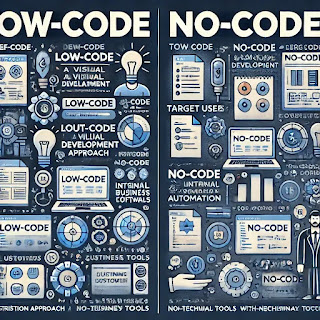Low-Code vs No-Code Development – Differences and Use Cases
As businesses strive for faster software development, low-code and no-code platforms have emerged as game changers. These approaches empower developers and non-technical users to build applications with minimal traditional coding. However, they differ in complexity, flexibility, and target users.
Let’s explore their differences, benefits, and use cases, along with visual representations.
WHAT IS LOW-CODE DEVELOPMENT?
Low-code development platforms provide a visual development interface combined with some coding flexibility. They require minimal coding, enabling developers to create applications faster.
KEY FEATURES OF LOW-CODE PLATFORMS:
Drag-and-drop UI components
Pre-built templates and integrations
Customization with scripting (JavaScript, Python, etc.)
Requires some coding knowledge
ADVANTAGES OF LOW-CODE:
✔️ Faster development compared to traditional coding
✔️ Allows developers to customize applications
✔️ Supports complex workflows
✔️ Integrates with existing systems easily
USE CASES OF LOW-CODE DEVELOPMENT:
Enterprise Applications – Banking, insurance, and healthcare use low-code platforms to automate workflows.
Business Process Automation – Automating internal processes like HR onboarding, inventory tracking, and customer service workflows.
Custom Web & Mobile Apps – Developers use low-code tools like OutSystems, Mendix, and Microsoft PowerApps to build apps quickly.
WHAT IS NO-CODE DEVELOPMENT?
No-code platforms allow non-developers to create applications using 100% visual interfaces—without writing a single line of code.
KEY FEATURES OF NO-CODE PLATFORMS:
Drag-and-drop UI builder
Pre-built logic and automation
No coding required
Simplified app deployment
ADVANTAGES OF NO-CODE:
✔️ Ideal for business users with no technical skills
✔️ Faster deployment compared to low-code and traditional development
✔️ Reduces IT dependency
✔️ Cost-effective for startups and small businesses
USE CASES OF NO-CODE DEVELOPMENT:
Internal Business Tools – Non-technical teams build dashboards and project management tools.
E-commerce & Websites – Platforms like Wix, Shopify, and Webflow help businesses create online stores.
Marketing Automation – No-code tools like Zapier and Bubble automate email campaigns and CRM workflows.
Prototyping & MVPs – Startups use no-code tools to create prototypes before investing in full-scale development.








No comments:
Post a Comment